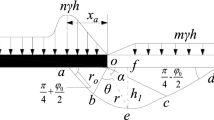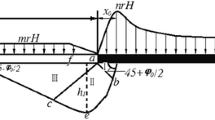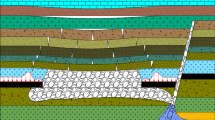Summary
Floor failure and excessive heave in underground coal mines can jeopardize the stability of the whole structure, including the roof and pillars, due to differential settlements and redistribution of stress concentrations. Besides, floor failure is detrimental to haulageway operation and can lead to unacceptable conditions of high deformation. Thus, the design of any underground opening must consider roof/pillar and floor as one structural system.
This paper presents guidelines for the design of mine floors, including the necessary field and laboratory investigations and the determination of the bearing capacity of floor strata. The design methodology is based essentially on a modified Hoek-Brown rock mass strength criterion. The main modifications are the introduction of the concept of the point of critical energy release to account for the long term strength, the inclusion of tensile strength and the adoption of a lithostatic state of stress in the rock mass. The determination of the dimensionless parametersm ands result from correlations with the RMR (“rock mass rating”) of the Geomechanics Clasification. Nine case histories, both in longwall and room and pillar coal mining, were analyzed with the proposed methodology.
Similar content being viewed by others
References
Allwes, R. A., Listak, J. M., Chekan, G. J., Babich, D. R. (1985): The Effects of a Retreating Longwall on an Three Entry Gate Road System. USBM, RI 8966 (19pp.).
Atkinson, I. H. (1981): Foundation and Slopes. New York: McGraw-Hill, 350 pp.
Barton, N., Lien, R., Lunde, J. (1974): Engineering Classification of Rock Masses for the Design of Tunnel Support. Rock Mechanics6, 4, 183–236.
Bieniawski, Z. T. (1967): Mechanism of Brittle Fracture of Rock. International Journal of Rock Mechanics and Mining Sciences4, 395–430.
Bieniawski, Z. T. (1976): Rock Mass Classifications in Rock Engineering Applications. Symposium on Exploration for Rock Engineering. Rotterdam: A. A. Balkema, pp. 97–196.
Bieniawski, Z. T. (1979): The Geomechanics Classification in Rock Engineering Applications. 4th International Congress on Rock Mechanics, Montreaux, ISRM, vol. 2, 41–48.
Bieniawski, Z. T. (1984): Rock Mechanics Design in Mining and Tunnelling. A. A. Balkema, 272 pp.
Bieniawski, Z. T.: Strata Control in Mineral Engineering. J. Wiley & Sons 212 pp.
Choi, D. S., McCain, D. L. (1983): Ground Control Aspects of Longwall Coal Mining. Conference of Rapid Excavation and Tunnelling. New York: AIME, vol. 1, 178–179.
Coates, D. F. (1966): Pillar Loading—A New Hypothesis. Canada Department of Mines and Technical Service, Mines Branch Resesarch Reports R168, R170 and R180.
Coulomb, C. A. (1773): Sur une application des règles de Masimis et Minimis a quelques problèmes de statique relatifs à l'Architecture. Academie Royal des Sciences Memoires de mathematique et de physique par divers savans, vol. 7, 343–382.
Faria Santos, C. (1988): Analysis of Floor Stability in Undergrond Coal Mines. PhD thesis, The Pennsylvania State University, 205 pp.
Griffith, A. A. (1921): The Phenomena of Rupture and Flow in Solids. Philosophical Transactions of the Royal Society, London, series A,221, 163–168.
Grim, R. E. (1968): Clay Mineralogy. New York: McGraw-Hill, 596 pp.
Heim, A. (1878): Mechanismus der Gebirgsbildung. Bâle.
Hoek, E. (1983): Strength of Jointed Rock Masses. 23rd Rankine Lecture, Geotechnique33, 187–223.
Hoek, E. (1986): Notes on the Relationship Between Rock Mass Classification and Rock Mass Strength. International note (unpublished), Golder Associates, Vancouver, 6 pp.
Hoek, E. (1988): Personal communication.
Hoek, E., Brown, E. T. (1980): Empirical Strength Criterion for Rock Masses. Journal of Geotechnical Engineering, ASCE106, no. GT 9, 1013–1035.
Hsiung, S. M., Peng, S. S. (1985): Chain Pillar Design for U. S. Longwall Panels. Mining Science and Technology. Amsterdam: Elsevier,2, 279–305.
Londe, P. (1988): Discussion on the paper “Determination of shear failure envelope in rock masses” by R. Ucar. Journal of Geotechnical Engineering, ASCE114, 3, 374–376.
Mark, C. (1987): Analysis of Longwall Pillar Stability. PhD thesis, The Pennsylvania State University, 415 pp.
Murrell, S. A. F. (1965): The Effects of Triaxial Stress Systems on the Strength of Rocks at Atmospheric Temperatures. Geophysics Journal10, 231–281.
Scheurger, M. G. (1985): An Investigation of Longwall Pillar Stress History. 4th Conference of Ground Control in Mining. Morgantown, WV, 41–50.
Talobre, J. A. (1967): La mécanique des roches (12 ème edition). Paris: Dunod, 442 pp.
Terzaghi, K. (1942): Theoretical Soil Mechanics. J. Wiley & Sons, 300 pp.
Ucar, R. (1986): Determination of Shear Failure Envelope in Rock Masses. Journal of Geotechnical Engineering, ASCE112, 3, 305–315.
Wilson, A. H. (1983): The Stability of Underground Workings in the Soft Rocks of the Coal Measures. International Journal of Mining Engineering1, 2, 91–187.
Author information
Authors and Affiliations
Rights and permissions
About this article
Cite this article
Faria Santos, C., Bieniawski, Z.T. Floor design in underground coal mines. Rock Mech Rock Engng 22, 249–271 (1989). https://doi.org/10.1007/BF01262282
Issue Date:
DOI: https://doi.org/10.1007/BF01262282




